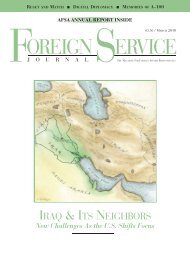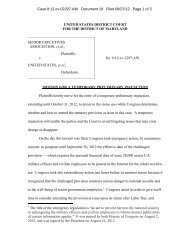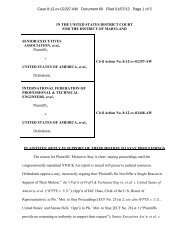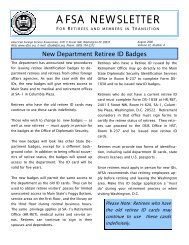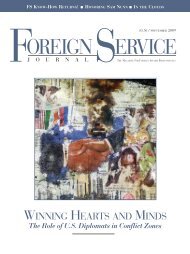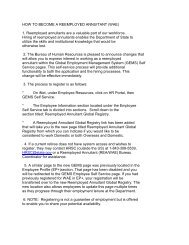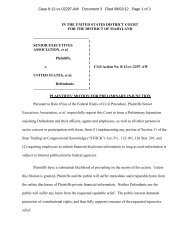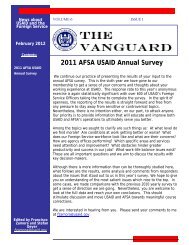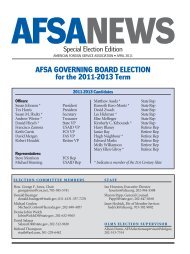F OCUS - American Foreign Service Association
F OCUS - American Foreign Service Association
F OCUS - American Foreign Service Association
You also want an ePaper? Increase the reach of your titles
YUMPU automatically turns print PDFs into web optimized ePapers that Google loves.
ecame increasingly chaotic, with<br />
crew members frantically donning<br />
parachutes, it was Davies who finally<br />
broke “the impasse of general fear” by<br />
being the first to jump, followed<br />
immediately by Duncan Lee and five<br />
others. The disabled plane then barely<br />
cleared the ridgeline constituting<br />
the Burma-India border, and the<br />
remaining passengers, including<br />
Sevareid, jumped just in time to avoid<br />
being trapped as it spun out of control<br />
(the co-pilot was the sole fatality).<br />
The survivors now found themselves<br />
in one of the most remote and<br />
dangerous regions in Asia. Only six<br />
years had transpired since the first<br />
Western expedition had reached<br />
Pangsha, the Naga tribal village near<br />
which the survivors ultimately gathered.<br />
(Ponyo, the village on the<br />
Burma side where Davies had landed,<br />
had never been visited by Europeans.)<br />
Christoph von Fuerer-Haimendorf,<br />
an Austrian anthropologist who<br />
took part in that first expedition,<br />
explained the reasons why the area<br />
was so little known. “The long seclusion<br />
of the Naga Hills has been due to<br />
… the inhospitality of the country …<br />
and the warlike character of the Naga<br />
tribes. … Headhunting and frequent<br />
wars made … traveling alone or even<br />
in small groups … a venture little short<br />
of suicide.” Indeed, the purpose of<br />
the British expedition on which he had<br />
been an observer had been punitive<br />
— Pangsha warriors had been among<br />
the most feared in the area (“thick<br />
bundles of human heads” were<br />
found), and the village was burned as<br />
a warning.<br />
As it turned out, during the two<br />
weeks that the survivors remained in<br />
Pangsha the villagers, despite their<br />
reputation, were generally helpful,<br />
even dutifully delivering the weapons<br />
that were airdropped to the party as a<br />
precaution. One factor that helped<br />
cement relations was the arrival on the<br />
afternoon of the day of the crash of Lt.<br />
Col. Donald Flickinger, a flight sur-<br />
48 FOREIGN SERVICE JOURNAL/JULY-AUGUST 2008<br />
“If ever again I were in<br />
deep trouble, one man<br />
I would want to be with<br />
would be [Davies].”<br />
— Eric Sevareid<br />
geon who, on learning there was an<br />
injured member of the party, parachuted<br />
in with two other volunteers.<br />
After seeing to the needs of the<br />
injured survivors, Flickinger set up a<br />
clinic for the villagers, earning their<br />
gratitude. He also asked Davies to<br />
continue as the principal intermediary<br />
with the villagers. As Sevareid later<br />
wrote, “He was the one we chose, for<br />
common sense and discretion, to deal<br />
with the touchy and dangerous Naga<br />
headhunters, our undecided hosts.”<br />
In the absence of landing strips or<br />
roads, walking out of the area was the<br />
only option, and that was especially<br />
hazardous in August. Speaking before<br />
the Royal Geographical Society in<br />
1938, von Fuerer-Haimendorf noted<br />
that “Traveling in the Naga Hills during<br />
the rains, which last from April to<br />
the end of September, is most<br />
unpleasant and can become extremely<br />
difficult when one leaves administered<br />
territory.” Leaving Pangsha on Aug.<br />
18, escorted by a party of armed natives<br />
led by the British deputy commissioner<br />
of the Naga Hills, Philip<br />
Adams, the survivors struggled<br />
through a brutal six-day trek that taxed<br />
everyone to the limit.<br />
While Flickinger did yeoman service<br />
on the medical front, Sevareid<br />
credits Davies’ unflagging steadiness<br />
and humor with keeping up morale.<br />
“On the toughest parts of hills … he<br />
will do loud, very funny variations on<br />
natives’ chants, which amuses them<br />
greatly.” Summing up his view of<br />
Davies’ contribution throughout the<br />
ordeal, Sevareid later wrote, “If ever<br />
again I were in deep trouble, one man<br />
I would want to be with would be this<br />
particular man.” For Sevareid, Davies<br />
had defined grace under pressure.<br />
“A Vicious Line Squall”<br />
Dean Acheson used this phrase to<br />
describe the impact of Patrick J.<br />
Hurley, an Oklahoman who had<br />
served as Secretary of War under<br />
Herbert Hoover. Sent by Pres.<br />
Roosevelt in August 1944 to try to<br />
mediate the growing hostility between<br />
Gen. Stilwell and Chiang Kai-shek, he<br />
eventually sided with Chiang and was<br />
named ambassador to China three<br />
months later, shortly after Washington’s<br />
decision to withdraw Stilwell.<br />
Acheson found it hard to conceal his<br />
dislike of Hurley: “Trouble moved<br />
with him like a cloud of flies around a<br />
steer.”<br />
Although his tenure as ambassador<br />
lasted only one year, Hurley managed<br />
to inflict enormous damage on China<br />
policy, on the Truman administration,<br />
on the <strong>Foreign</strong> <strong>Service</strong> and on the<br />
careers and lives of Davies and the<br />
other “China hands,” whose reporting<br />
and policy assessments provoked his<br />
wrath. On Jan. 9, 1945, Hurley accused<br />
Davies to his face of being a<br />
communist and “roared at the top of<br />
his lungs that he was going to have him<br />
thrown out of the State Department”<br />
— a bitter foretaste of the McCarthy<br />
era to come.<br />
The long, sad, tangled story of the<br />
inquisition Davies and the others<br />
endured over the next decade has<br />
often been told. Readers are encouraged<br />
to visit the very helpful Web site<br />
of the <strong>Association</strong> for Diplomatic<br />
Studies and Training (www.usdiplo<br />
macy.org/history/service/chinahands.<br />
php) for an excellent summary with<br />
links to other sources. The classic<br />
book by New Yorker writer E.J. Kahn,<br />
The China Hands: America’s <strong>Foreign</strong>



